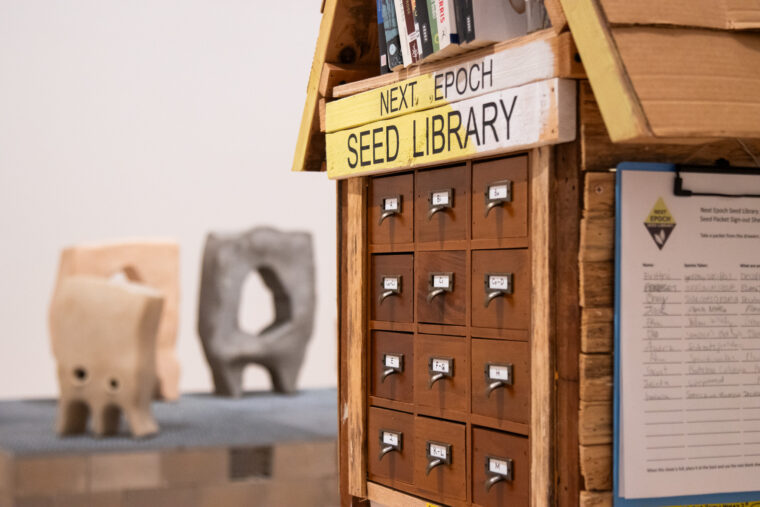Scene
Seeds of tomorrow: Kemper Art Museum’s newest exhibition

A seed library that is part of the Kemper Museum’s “Seeds: Containers of a World to Come” Art Exhibit (Eran Fann | Photo Editor).
From soil degradation to waste disposal, the ecological concerns of the 21st century are becoming increasingly worrisome. Aiming to highlight these environmental risks and sustainability challenges, the Mildred Lane Kemper Art Museum unveiled its new exhibition titled “Seeds: Containers of a World to Come,” on Feb. 21. Running until July 28 2025, the artworks featured in the exhibition center on seeds and their ability to serve as symbols of the environment’s diverse and regenerative future.
The exhibition was curated by Meredith Malone, an associate curator at Kemper and admirer of art’s ability to advance social issues. Through her role, Malone seeks to broaden the scope of the museum’s collection to address various societal issues — the environmental crisis being a pivotal one.
“Sometimes the environmental crisis can [be] so overwhelming and abstract, but through the visual arts, we can have a different entry point to understanding it,” Malone said.
In order to convey environmental timeliness, Malone landed on seeds to be the focal point of the exhibition’s works, showcasing their everlasting importance to environmental prosperity.
“Seeds are actually pretty interesting when you think about them. They are the first link in the food chain, an embodiment of biological and cultural diversity, and they also have a repository of life evolution,” Malone said.
The exhibition features a large range of three-dimensional works from artists around the globe. The exhibition includes art inspired by representations of seeds themselves, mechanisms that house seeds and their growth, and cultural portrayals of seeds in an attempt to highlight varying geographical climates. Each of the pieces are subtly intertwined, an idea emphasized by environmentalist and artist Anne Percoco, whose seed library is featured as a work in the exhibition.
“I am just thrilled to be in a show that has such a lively dialogue between all the works,” Percoco said.
One local St. Louis artist, Juan William Chávez, is passionate about combating climate change locally. His piece, “Decolonize the Garden Seeds to Bees,” features a series of handcrafted sculptures called “survival blankets.” Each blanket is composed of myler, the material of the blankets used in U.S. immigration detention centers. Chavez also has potatoes made of concrete and objects from his family on display, all connecting to his Peruvian roots. As a whole, the work brings attention to the immigration crisis and Chavez’s strong political convictions.
“Ultimately, he sees the blankets as a portable version of the garden that he has in nursing,” Malone said.
On a global scale, the exhibition showcases how the climate crisis affects various terrains. Beatriz Cortez, a contemporary artist who immigrated from El Salvador after the war in 1989, is the creator of the oval shaped pod made out of steel that houses seed containers. The back side of the pod contains a living garden.
“This is like a space pod with the intention of preserving seeds for humans of the future. Also, she’s thinking about some NASA kind of experiments such as growing plants in a mini natural space station” Malone said.
Connecting to her El Salvadoran roots, the pod is meant to represent chultuns, a technology that Mayans used to dig pits and caves underground to hold water, food, and seeds. The different containers of seeds are representative of Mayan culture and feature bioproducts such as corn, potatoes, and amaranth. The seed vessels are meant to highlight timelessness.
“Seeds themselves are tiny little time travelers. They can remain dormant for long periods of time, and then they can wake up again. They embody that link to a cultural image,” Malone said.
The exhibition allows visitors to actively engage with seeds through a seed library — drawers of seed packets from different weedy species in St. Louis, enclosed by a roof in the exit, created by Anne Percoco and Ellie Irons, a New York based environmentalist. The two have been working together for 10 years and collect weeds in various locations, moving the library with them.
“There’s a lot of interesting sites and property that’s been abandoned around St. Louis. We visited super fun sites like a burned out library, the car police, Manuscript Library and River Des Peres,” Percoco said. “Any place is cool for us to collect weeds, because they have had to adapt, change and deal with pollution and higher temperatures due to the urban heat island effect. They have accommodated to have a form of superpowers.”
Collectively, the unique pieces in this exhibition offer viewers a chance to see the environmental crisis through a novel lens and to question how they can uphold environmental prosperity in the future.
“I want you to think about what the relationship between fragility, preservation and possibility is. What do those terms mean? How does preservation function on multiple different levels?” Malone said.
Whether passionate about the climate crisis, contemporary art, or gardening, this exhibition has something for everyone and is exemplary of Kemper’s ability to transform spaces to address pressing societal issues.
